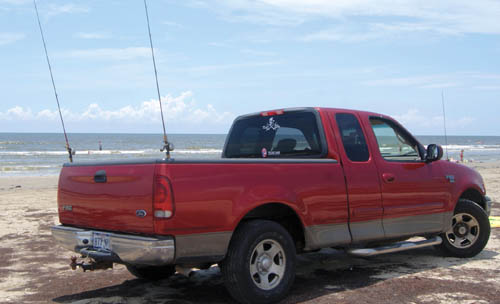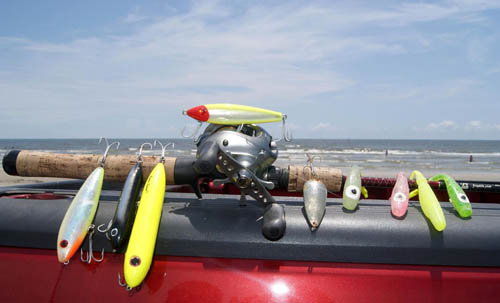
The Saltwater Magazine for Gulf Coast Fishing!
FISHING FORECASTS
| FISHING CALENDARS | ARTICLES | ADVERTISE
| SUBSCRIBE
Search Gulf Coast Fisherman's
Web Site
Past articles, specific
places or fish, etc.

From Asphalt to
the Sand...
Surf fishing tactics that will keep your
tires dirty and your lines tight!by Capt. Nate Skinner
| CURRENT
MOON lunar phases |

The transition from late summer to early fall on the Texas Gulf Coast sparks a feeding frenzy among the water's top predators and gamefish. Schools of baitfish and shrimp will start a slow migration process, moving from the bays and estuaries, back to the saltier waters of the Gulf as the season begins to change. With this migration, you can bet that some toothy, hard hitting, spotted predators are not far behind looking for an easy meal. For anglers, this means one thing - the surf is on fire, and full of speckled trout.
When the surf goes flat during the fall months, it's time to get some sand on those tires and wade out into the Gulf of Mexico. The Upper Texas Coast, from McFaddin Beach to San Luis Pass, offers nearly 100 miles of sun drenched beaches that are lapped by the salty, gamefish filled waters of the Gulf, much of which are free to public and vehicle access.
Driving the Beach
There are a few things to keep in mind when driving the beach in search of a place to get out and fish. Purchasing a "hot spot" map from one of the area sporting goods stores or bait camps can make driving the beach easier. Some maps will clearly define where it is legal to operate a motorized vehicle on the beach, where all public beach access points are located, and a few tips as to what sections of the area's beaches are typical "honey holes" for fishing.
You may want to have a handheld or dash mount GPS in your vehicle to mark spots along the beach which have been successful for you personally. Miles and miles of sand can all look the same, and having a GPS coordinate on a productive area will help you consistently find fish along the surf faster, decreasing your searching time.

The most important thing to remember while driving the beach is the limitations of your vehicle. Most of the beaches along the Upper Texas Coast are relatively flat and easily navigable by even the smallest of two-wheel drive cars.
However, there are a few areas with more rugged terrain, larger dunes, or places that can become "sloshy" after ample amounts of rain, where a four-wheel drive vehicle would be the only practical means of traveling the beach.
Combining this knowledge with an area's regulations on public and vehicle access will prevent many unwanted headaches. It would be frustrating to return home from a surf fishing trip having spent a few hundred dollars getting your truck pulled out of the dunes or on a beach violation fine.
What to Look For
Knowing some key signs to look for can help shorten your search for productive water. Using binoculars will make finding these "fishy" signs easier. The most obvious of these signs are the presence of slicks and bait. Slicks are pro-duced by actively feeding fish as they burp on baitfish they are pursuing and consuming.
Fresh slicks will appear small and round. They will also produce a sweet smell similar to fresh cut watermelon and reveal the general area of where the fish are feeding. The slicks will tend to spread out into a more irregular oval as the wind and current move them from their place of origin. If you find an area with these larger slicks, the fish producing them may only be a few yards or so down the up-current direction of the beach.
An ideal situation would be to find some larger slicks moving with some fresh, smaller slicks popping up behind them. Finding this, combined with a generous amount of bait fish in the water gives you a productive looking stretch of surf to work with.
The surf angler will prefer an area with "active" bait that looks scared. This could be the constant flipping and jumping of mullet, balls of swarming glass minnows, or shrimp fleeing from large swirls produced by slurping trout. Using binoculars to scan the surf for diving birds can help an angler key in on concentrations of bait. Finding a group of birds diving and hovering low over the water can indicate schools of trout feeding on baitfish and shrimp that they have pushed to the water's surface.
Keying in on structures in the surf can increase an angler's chances for success. Upper Texas coast beaches are lined with rock groins and jetties. As the current moves past these rock structures, eddies are created on the down current side of the groin or jetty. Baitfish use these eddies to rest from a swift current, drawing trout and other gamefish in search of an easy meal, and making these structures an ideal place to target during times of strong tidal movement.
Another type structure to look for in the surf is a bar and gut scheme. You can find these by walking around in the surf and observing water depth changes, watching where waves are breaking along the beach, or by looking from higher elevations when the water is clear. Once a series of bars and guts are located, an angler can position himself on a bar and cast into a gut where fish are waiting for bait being swept by current in the deeper water.
What to Throw
The trout you hook in the surf are a "different breed" of fish, as they seem to hit and pull a lot harder than fish hooked in the bay. These fish have grown up under much stronger currents, making them more aggressive. This means you'll want to you use a tough and dependable line. I recommend at least 30 lb. test Power Pro braid, or 15 lb. test mono-filament with a 30 lb. test leader if you are uncomfortable with throwing braid.
The fish in the surf will definitely be willing to eat live bait such as a shrimp or mullet rigged under a popping cork or free-lined with a small split shot; however, I think that because these fish are so aggressive, artificials can be just as effective as live bait.
There are four types of lures that can make any angler successful in the surf. These include topwaters, MirrOlures, spoons, and soft plastics. Deciding which type to throw depends on where the fish are feeding- below the surface, or on top? Once this is determined, all that's left to know is what color combination to throw. For the surf I recommend bright and shiny. It's as simple as that! Anything that is going to get their attention is likely to be a successful lure.
Hot topwaters for me in the past have been chrome and chartreuse Super Spooks, Super Spook Jr.'s and Skitterwalks. Brightly colored soft plastics rigged on quarter or eighth ounce jig heads are always a "go to" bait in the surf, as well as chartreuse or white 51MR MirrOlure. Silver or gold spoons work great when thrown during sunny days. Retrieving any of these lure/color combinations in a rapid, sporadic motion should entice bone crushing hits from game fish in the surf during the fall.
Upper Texas Coast Beaches
Combining the aforementioned knowledge with the nearly 100 miles of beach that the Upper Texas Coast has to offer will bring you consistent success in the surf this fall. Starting from Sea Rim State Park, and stretching west some 20 miles to High Island, Texas is McFaddin Beach. Southwest of McFaddin begins the 27 mile stretch of beach that lies on Bolivar Peninsula, spanning from Roll Over Pass to Port Bolivar. The sand along Bolivar Peninsula forms Crystal Beach on its east end, as it transitions to an area known as the Bolivar Pocket, which runs to the Southwest tip of the Peninsula meeting the North Jetty of Galveston Bay. Across the Galveston Channel from the north jetty, lies the south jetty and the beginning of the 32 mile stretch of beach front on Galveston Island. The Southwest tip of Galveston Island forms another meeting of the Gulf and estuarine waters known as the San Luis Pass, which accounts for about 14 miles of beach before meeting Surfside Beach, Texas.
Each of the beaches mentioned above contain a plethora of spots and areas full of "fishy" signs sought after by surf anglers, the majority of which are free to public and vehicle access.
If you find yourself in the surf around High Island at McFaddin Beach,
be on the lookout for Marcus Heflin and his Christian Surf Fishing Adventures
crew. Heflin heads up this surf fishing ministry that puts on numerous
weekend surf fishing retreats. The organization offers surf fishing tips
and knowhow to beginners and people of all ages while ministering to them
as well. Another surf specialist is Captain Jimmie Bankston of Texas Best
Guide Service based out of Galveston, Texas. Bankston charters specialty
surf trips in the late summer and fall, and is sure to show you the ropes,
not to mention a great time, if you are new to surf fishing.
[ Articles
|
Home ]

